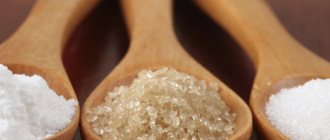Sour cream for pancreatitis is used in small portions, since the fermented milk product is quite high in calories and contains a large amount of fat, which is contraindicated for problems with the pancreas. It is not recommended to include sour cream in the menu as an independent dish; it can be added to salads or used as an additive to main courses. You can consume sour cream only if the patient is in a stable condition. Exhausted by therapeutic fasting and a strict diet, the body needs vitamins and beneficial elements, which are contained in large quantities in sour cream. If possible, sour cream is replaced with kefir, yogurt, yogurt and cottage cheese, since these fermented milk products also contain many useful components and at the same time are not a burden for the damaged pancreas.
It is recommended to use sour cream for pancreatitis only during a period of stable remission, when the patient has no symptoms of pancreatitis, and tests confirm the stability of the health status.
Is it possible or not to eat sour cream if you have pancreatitis?
It is prohibited to use sour cream in the acute phase of pancreatitis due to the high content of fats and calories in the product. Eating sour cream even in small quantities during exacerbation of pancreatitis can aggravate the patient’s condition, since such a product is an unreasonable burden on the pancreas. However, you need to keep in mind that sour cream is healthier than butter and cream, since it contains a small percentage of cholesterol, and protein and fats are easily digested due to fermentation.
Sour cream can be introduced into the diet of patients with pancreatitis during stable remission, when all test parameters are normal and the patient does not complain about symptoms characteristic of the disease.
Sour cream is allowed to be included in the diet, taking into account the characteristics of the patient’s condition. In case of long-term or persistent steatorrhea (loose stools and detection of undigested fats in the stool), it is not allowed to consume sour cream. Even if you feel well, steatorium indicates problems with digestion, and especially with the digestion of fats by the pancreas.
Sour cream should be introduced into the diet with caution, starting with small portions and coordinating its use with a nutritionist. You need to start consuming sour cream with one teaspoon every other day. The choice should be made with low-fat sour cream (10 - 20%). When purchasing, you need to pay attention to the expiration date and quality of the fermented milk product. It is not recommended to use sour cream containing vegetable fats, thickeners, preservatives, or stabilizers. The healthy product should contain only cream, milk and sourdough.
Sour cream for pancreatitis can be used as an additive in various dishes, for example, with sour cream you can prepare pudding, casseroles, sauces for meat dishes, and you can season salads with the product.
When using sour cream in limited portions, it is possible to enrich the diet with a healthy product, adding new flavors to dietary dishes.
Chronic stage
In case of a serious exacerbation, the principles of nutrition for patients with chronic pancreatitis are identical to the dietary requirements for patients with acute pancreatitis. Next, in the phase of subsiding exacerbation, a high-protein gentle diet is prescribed. Cottage cheese is its integral component. With satisfactory tolerability (no pain, nausea, diarrhea, vomiting, stable laboratory values), its fat content is increased to 5%. It is allowed in its natural form, as part of casseroles, soufflés, and puddings (it can be mixed with cereals, noodles, and meat).
When the disease enters remission, patients can already consume half-fat cottage cheese (up to 9%). Lazy dumplings and the filling of savory baked goods are added to the list of permitted curd dishes.
In stable remission of pancreatitis, patients can try 20% cottage cheese, but it:
- may provoke an exacerbation if the remission is fragile;
- impairs the absorption of calcium, which is valuable for the preservation of bone mass, hair, and teeth (cottage cheese is extremely rich in this mineral: 100 g - 164 mg);
- does not promote weight loss (low-fat cottage cheese is used for nutrition on fasting days, its lecithin removes excess cholesterol).
Therefore, it is better to eat it not daily, but 2 or 3 times a week.
In the chronic form of the disease, patients are also required to follow a diet. There is protein food on the table that is easily digestible. Cottage cheese acts as one of the main products.
It is very important to monitor the patient’s condition and how the body reacts to food. If the patient does not feel sick, there is no diarrhea, no bloating, in case of pancreatitis, curd mass of 9% is included.
This milk product can be consumed in its pure form or made into dishes using it.
- Souffle.
- Casseroles.
- Puddings.
It is also useful to mix the ingredients, for example, with pasta and vegetables. You shouldn’t experiment with the volume and fat content of cottage cheese yourself. The consumption process is controlled by a doctor.
If a stable remission is observed, patients with pancreatitis can be carefully introduced to cottage cheese dishes with 20% fat content. It is worth remembering that the situation may worsen when remission has unsatisfactory durability. Also, curd mass with high fat content can inhibit the absorption of calcium and overload the digestive system.
After the patient has completed a course of therapeutic fasting, cottage cheese can be added to the menu for 2-3 days. The main thing in this case is to observe the principle of fractionation, when food is consumed often and in small portions, and also not combining cottage cheese with milk - this can lead to irritation of the pancreas.
Low-fat cottage cheese
Speaking about what kind of cottage cheese you can eat with pancreatitis, in order to avoid provocation and the development of an exacerbation of the diagnosis, it is worth taking into account certain points. Speaking about what kind of cottage cheese you can eat for pancreatitis, it is worth introducing into your diet a product whose fat content does not exceed 3%. The product itself must be fresh - you should buy it from a trusted seller or you can prepare it yourself.
To always eat cottage cheese fresh, preparing it yourself is not difficult. In this case, take 1 liter. milk and boil it, then pour the juice of ½ lemon into it and when it curdles, remove the pan from the stove. Strain the whey through two layers of gauze - when all the excess liquid has drained, the homemade fermented milk product is ready for use.
When the disease worsens, when introducing a menu into the diet, you should adhere to certain principles. When inflammatory processes subside and in the absence of intolerance to the cottage cheese itself, which manifests itself in nausea and vomiting, diarrhea, the fat content of the consumed product can be gradually increased to 4 - 5%.
Doctor's recommendations
During remission of pancreatitis, the percentage of fat content of the consumed fermented milk product can be gradually increased to 9%. In this case, it is served in the form of a soufflé and in combination with all kinds of cereals, pasta or meat. Lazy dumplings and baked goods without baking, with the addition of cottage cheese, casserole, and mousse can be introduced into the patient’s diet.
Speaking about whether it is possible to eat it with pancreatitis, dishes in which a larger percentage of the ingredients are cottage cheese, it is worth remembering that it itself can cause an exacerbation of the disease if the remission of the disease is not sufficiently stable. At the same time, a large percentage of fat content is always not only a burden on the digestive tract, but also a slowdown in the absorption of such an important element as calcium.
In case of acute exacerbation of chronic pancreatitis, doctors prescribe the patient a hunger strike, and then prescribe a gentle protein diet. There is no way here without cottage cheese. If the patient tolerates this product well (without nausea, diarrhea, vomiting and abdominal pain), then cottage cheese with a higher fat content is included in the diet - first up to 5%, and over time it reaches 9%.
You can eat it in its natural form or mix it with cereals, meat, and pasta. It is also acceptable to eat other dishes made from cottage cheese - puddings, casseroles, soufflés.
Despite the fact that cottage cheese is a very useful product for pancreatitis, you do not need to independently experiment with the size and quantity of its daily servings, and also eat cottage cheese with a high fat content without a doctor’s permission. With this disease, it is necessary to adhere to a strict diet and very carefully monitor the daily intake of cottage cheese.
Sour cream for cholecystopancreatitis
The pancreas and gallbladder normally secrete enzymes into the digestive system that help carry out normal digestion. The difference between these organs is that the gallbladder does not produce bile, but is a reservoir for its accumulation, and the pancreas produces pancreatic juice.
Very often, inflammation of one organ is accompanied by damage to another, and it is sometimes difficult to determine whether cholecystitis caused pancreatitis or vice versa. The combination of these two diseases is called cholecystopancreatitis, although pain in this case is localized in the pancreas.
The diet for cholecystopancreatitis does not differ from the special nutrition system intended for pancreatitis (dietary table number 5). Patients are recommended to use light foods that do not complicate the digestion process and do not contain large amounts of fat. Using sour cream in this case is also allowed after the onset of stable remission, starting with small portions, as an additive to main dietary dishes.
Composition and beneficial properties
Sour cream contains a large amount of easily digestible proteins and milk fats. The product contains vitamins pp, b9, d, b5, b6, a, b1, b2, bp, s, b12, e, h. The fermented milk product is rich in minerals such as molybdenum, fluorine, iron, potassium, manganese, phosphorus, zinc, calcium, selenium, sulfur, sodium and cobalt.
The beneficial properties of sour cream are due to the fat-soluble vitamins a, e d, and group of vitamins B, which are necessary for the body to recover from pathological processes.
Milk sugar or lactose in sour cream accelerates the absorption of calcium and participates in the process of stabilizing intestinal microflora. The rich mineral composition of the product helps to normalize metabolic processes and has a positive effect on the digestive tract.
Consumption of fermented milk products allows you to activate the process of assimilation of food taken, satisfies hunger, and replenishes the body with necessary substances.
Sour cream is included in the diet for pancreatitis infrequently, only when necessary and in the stage of stable remission, since the high calorie content and increased fat content of the product can become an extra burden for the inflamed pancreas.
Nutritionists recommend consuming sour cream as an additive to salads, cereals or soups, since in this form the product is quickly absorbed and does not cause a negative reaction from the digestive tract.
How to choose the right product
When choosing sour cream, you need to pay attention to the expiration date and composition. You should use products made from natural ingredients, cream, and fermented milk starter. It is unacceptable to consume sour cream containing vegetable fat, preservatives, starch, or stabilizers. The quality of sour cream is determined by GOST 52092 -2003. The presence of the BIO prefix on sour cream indicates a composition enriched with bifidobacteria and pribiotics. If the product contains live microorganisms, the package contains the prefix "coe".
Natural sour cream is suitable for use within 14 days from the date of production, and after opening the package - 72 hours. If a product indicates a shelf life of about 30 days or more, it means the product was produced at high temperatures. This heat treatment allows you to store the fermented milk product longer, but destroys lactic acid bacteria. Fermented milk product processed using high temperatures is not healthy and lacks nutrients and microorganisms necessary for the body.
Features of consuming sour cream for pancreatitis
For pancreatitis, it is allowed to use sour cream with a low fat content, without artificial additives, and always fresh.
The product can be introduced into the diet only when the digestive process has stabilized, in limited quantities, and in no case as an independent product. After therapeutic fasting and a strict diet, sour cream helps replenish the body with useful substances and gives the patient tone. However, you should not get carried away with the product; even during periods of stable remission, you should use it in small portions, best as a sauce for salads, or as an additive to soups and cereals. Sour cream for pancreatitis is used in baked goods.
A fermented milk product should not be used if the patient has loose stools, stomach problems, or deterioration in health after consumption. You can replace sour cream with kefir, yogurt, and yogurt.
Nutrition during the acute stage of pancreatitis
In the acute stage of inflammation of the pancreas, cottage cheese is absolutely included in the menu, which is allowed immediately after the fasting phase, which is carried out after an attack. The specificity of pancreatitis is such that the patient requires extremely easily digestible food. Proteins received by a patient with cottage cheese will be absorbed much faster than from any meat that has been steamed and ground for quick digestion.
The acidity of the permitted product should not exceed 170 units on the Turner scale, fat content should not exceed 3%. It is best to purchase the product in a store, where its fat content is indicated, or prepare it at home from skim milk. The optimal form of use in the first days after therapeutic fasting is in a pureed homogeneous mass.
- limit inflammation;
- saturate the body with valuable building material;
- supply the necessary microelements and vitamins;
- stimulate the immune system;
- develop protease inhibitors.
In order not to cause harm to the patient, whose affected organ requires incredibly careful handling, in the first week after an acute attack, the cottage cheese should be non-sour, non-greasy, thoroughly pureed, without any food and flavor additives, in its pure form. If the recommendations are followed in this way, the body will receive the valuable components it needs in the form of a dairy product without causing harm to it.
- Is it possible to eat dates for pancreatitis of the pancreas?
- Drying for pancreatitis: is it possible to eat crackers for pancreatitis?
- Pancreatitis examination of the pancreas
- Folk remedies for pancreatitis of the pancreas reviews
Acute pancreatitis and sour cream
Acute pancreatitis is a rather serious disease and requires treatment using conservative therapy and a special diet. For the first three days of acute pancreatitis, the patient is prescribed therapeutic fasting and is only allowed to drink in the form of mineral water without gas or rosehip decoction. On the 5-7th day, pureed soups and cereals, vegetable puddings and purees are introduced into the patient’s diet. All dishes are allowed to be given to the patient in small quantities, carefully observing the body’s reaction. Fermented milk products can be added to the menu when the symptoms of the disease become mild or disappear completely. You should start taking fermented milk products with kefir in small portions. The use of sour cream during the period of acute pancreatitis is prohibited, since the product contains many minerals, fats, proteins and carbohydrates, and can cause enzymatic activity of the pancreas, aggravating the patient's condition. The most important thing at this phase of the disease is to stabilize the functionality of the pancreas and normalize the digestive process.
After the onset of stable remission, when relapses of the disease and its characteristic symptoms are not observed for several months, sour cream can be introduced into the menu in small portions and as an additive to main dietary dishes.
Cottage cheese in the acute stage of the disease
After the end of the fasting period, curd products can begin to be introduced into the patient’s diet on the second or third day. At the same time, you should adhere to the principles of fractional nutrition and not consume cottage cheese with milk, this provokes the development of irritation of the pancreas.
In order not to provoke the development of an exacerbation of the disease or deterioration of the patient’s condition, it is necessary to know about the peculiarities of consuming cottage cheese during this period.
- In order not to increase the load on the pancreas, it is necessary to introduce into the menu a product with a fat content of no more than 3%.
- The cottage cheese must be fresh, or it is better to prepare it yourself. To do this, you need to take a liter of milk (preferably pasteurized) and boil it. Pour the juice of half a lemon into the boiling milk, and when it curdles, remove the pan from the heat and discard its contents through a double layer of gauze. After the whey has completely drained, the homemade cottage cheese is ready.
- In order not to cause an increase in the acidity of gastric juice, the acidity of the cottage cheese should not exceed 170 Turner units.
- You can use the product in shabby form, or you can prepare steamed pudding.
- Calcium deficiency can be compensated for by dishes prepared from calcined cottage cheese. To prepare such a product at home, you need to add calcium (lactic acid or chloride) to the milk.
- You cannot consume curd pudding or mass daily, 2-3 times a week is enough.
- The amount of cottage cheese should not exceed 250 g. per day, and you should not eat more than 150 grams of this product at one time.
In the first days, they most often consume sweet mass, pudding or soufflé, but later salty cottage cheese products can be introduced into the diet.
Using sour cream for pancreatitis
Use sour cream for pancreatitis with caution, starting with small portions and as sauces, seasonings or additives to dietary dishes.
Sour cream is added to fruit salads. A meat soufflé served with a tablespoon of sour cream acquires a piquant taste. Sour cream can be added to the dough of dietary casseroles and cookies, to dietary borscht or puree soups.
When using sour cream, it is necessary to monitor the body's reaction. If consuming a fermented milk product causes diarrhea, digestive problems, or other bothersome symptoms, you should stop consuming it and eliminate sour cream from your diet.
Consuming sour cream according to the instructions of nutritionists and in the permitted quantity will allow you to replenish your body with useful and necessary substances without harm to your health, making your diet varied and interesting.
Sauce recipe
To make sour cream, it is better to purchase high-quality pasteurized or sterilized low-fat milk. The product should be poured into an enamel pan and heated slightly. Then leave for two to three days to sour, covering the container on top with a triple layer of gauze. The process takes place at room temperature.
The resulting cream should be heated to 40 degrees, but not boiled. Then add yogurt to them based on the proportion: for cream obtained from 3 liters of milk, you will need 30 ml. curdled milk. The ingredients are gently stirred until the product cools to 20 degrees. Place the mixture in a glass container and leave overnight at room temperature. In the morning, place the prepared sour cream in the refrigerator. After five to six hours it will be ready to eat.
You can also make sour cream using purchased cream. The main thing is that they are natural and with a fat content of no more than 15-20%. Yogurt or kefir is added to the cream. For 150 grams of store-bought cream you will need a tablespoon of kefir or yogurt.
You will be surprised how quickly the disease recedes. Take care of your pancreas! Over 10,000 people have noticed significant improvements in their health simply by drinking a morning drink...
Is it possible to eat condensed milk if you have pancreatitis and how can it harm you?
Condensed milk is very sweet and high in calories, rich in fat and carbohydrates. Therefore, such a product is very difficult to digest even during remission.
Useful properties and rules for using kefir for pancreatitis
Thanks to its use, patients with pancreatitis can receive the necessary amount of animal protein, which is indispensable for the normal functioning of the pancreas
Is it possible to eat ice cream if you have pancreatitis and what can you replace it with?
This sweet cold product does not belong to the dietary category due to the presence of large amounts of fat and sugar in its composition, not to mention many other negative nuances
Is it allowed to eat butter if you have pancreatitis?
High-quality cow butter is allowed to be eaten only during a period of stable remission. In this case, the main thing is to follow the indicated dose and not deviate from the rules of its use.
I don’t eat sour cream in its pure form, I just add it to baked goods or vegetable salads instead of mayonnaise.
I have chronic pancreatitis. I eat no more than one or two teaspoons of sour cream per day. I only buy the most expensive ones with an expiration date of no more than 7 days.
In case of pancreatitis, sour cream can be used to prepare a dietary sauce for meat and fish. You will need to bring 125 grams of sour cream to a boil. In another container, combine 125 grams of cold product and 25 grams of flour, which is pre-dried in the oven. Then mix the sour cream and flour mass and hot sour cream, bring to a boil again and filter.
Reviews
Dear readers, your opinion is very important to us - therefore, we will be glad to hear your feedback about sour cream for pancreatitis in the comments, this will also be useful to other users of the site.
Love
I love sour cream very much, I used it as a second breakfast almost constantly. When I got sick with pancreatitis and was prescribed a diet, I had to stop using it. The doctor allowed me to eat sour cream as a sauce for salads, and only during the period of remission.
Victoria
She fell ill with acute pancreatitis, and after several days of hunger she began to eat slimy porridges and pureed soups. Later, sour cream was allowed to be used as a sauce for dishes. Rice soup with chicken and sour cream, vegetable soufflé with sour cream are very tasty. The product allows you to diversify the menu and gives a special taste to dishes.
For chronic pancreatitis
Is it possible to use sour cream for chronic pancreatitis? The leading manifestations, when the doctor gives permission to use the product in moderation, are the absence of deterioration, the chronic stage and the course of the pathology without changes. After you are allowed to take sour cream, add it into your diet carefully, the initial portion is 1 teaspoon per day. You need to choose a low-fat product, up to 20%.
If there are minor pains and other changes in the functioning of the organ, and tests show deviations, this is considered an immediate condition for following a strict dietary table.
Particular attention should be paid to the patient's condition.
- The presence of diarrhea for a long time; there is unbroken food in the excrement.
- Diarrhea along with other symptoms, even if the general condition is excellent. These signs indicate the inability of the body and pancreas to cope with the fats present.
When pancreatitis is chronic, sour cream is consumed, including in various dishes.
Using sour cream, you can do:
- puddings;
- casseroles;
- use when preparing milk and sour cream sauce for meat dishes;
- dress salads with fruits and vegetables.
It is not recommended to eat fermented milk products every day; a break is taken.
It is better to eat in the first half of the day. Since it is oily, using it in the evening will put a lot of stress on the organ and cause discomfort, pain and fullness in the stomach.
Sour cream sauce is allowed, but due to the presence of a large amount of cholesterol, it can be combined with potatoes, meat, and fish. It is important to buy natural products. If homemade sour cream is used, then no more than 20% fat.










